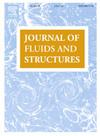规则波浪中两台并排潮汐流涡轮机的动载荷
IF 3.4
2区 工程技术
Q1 ENGINEERING, MECHANICAL
引用次数: 0
摘要
本文研究了两台并排1.2 m直径潮汐水轮机在规则波浪流中的动载荷试验。通过顶浪拖曳水轮机,探讨了叶尖速比、波浪幅值和波浪频率对平均和非定常转子和叶片载荷的影响。波浪中涡轮平均功率和推力系数与无波浪时记录的定常流动系数吻合较好。动态功率和推力系数描述了根据瞬时转子平均流速定义的叶尖速比在平均值周围形成滞回线的路径。单频谐波拟合为转子载荷提供了合理的拟合,从而可以根据入射波评估载荷相位。转子波动载荷随波浪幅值和叶尖速比增大而增大,随波浪频率增大而减小,转子转矩对波浪条件的敏感性大于推力。对叶片根部弯矩与波浪相位和叶片方位角的关系进行分析,发现叶片在迎波波峰和波谷之前,翼向和边缘方向的最大和最小载荷均出现在迎波波峰和波谷之前,而叶片承受最大和最小载荷的方位角位置是波浪频率的函数。与预期相反,当叶片近似水平时,发现叶片载荷最大,我们将其归因于波轨道运动学沿叶片的展向相关。随着波浪频率的增加,由于波浪轨道的垂直衰减增加,叶片载荷的最大值和最小值出现在靠近上死点的地方。在叶片的上冲程和下冲程处分别出现了叶片的扑翼和边缘载荷峰值,我们将其归因于波轨道的垂直分量和转子-转子干涉的贡献。由于转子之间近四分之一直径的间距,并联涡轮叶片载荷的差异归因于水动力相互作用。本文章由计算机程序翻译,如有差异,请以英文原文为准。
Dynamic loading of two side-by-side tidal stream turbines in regular waves
This paper investigates the dynamic loading of two side-by-side 1.2 m diameter tidal stream turbines tested experimentally in currents with regular waves. By towing the turbines through a tank against head waves we explore the influence of tip-speed ratio, wave amplitude and wave frequency, on the mean and unsteady rotor and blade loads. Turbine mean power and thrust coefficients in waves agree well with the steady flow coefficients recorded without waves. The dynamic power and thrust coefficients describe paths forming hysteresis loops around mean values when presented against tip-speed ratio defined based on instantaneous rotor-averaged flow speed. Single frequency harmonic fits provide reasonable fits to rotor loads enabling the assessment of loading phase with respect to incident waves. Rotor fluctuating loads increase with wave amplitude and tip-speed ratio, but decrease with wave frequency, with rotor torque showing greater sensitivity to wave conditions than thrust. Analysis of blade root bending moments as a function of wave phase and blade azimuth reveals that flapwise and edgewise load maxima and minima occur in advance of the crests and troughs of the approaching waves, but that the azimuthal locations at which blades experience maxima and minima are functions of wave frequency. Contrary to expectations blade loading is found to be maximum when blades are approximately horizontal which we attribute to spanwise correlation of wave orbital kinematics along blades. As wave frequency is increased, blade load maxima and minima occur closer to top dead centre due to increased vertical decay of wave orbitals. Peak flapwise and edgewise blade loads are found to occur on blade upstrokes and downstrokes respectively which we attribute to the contribution of the vertical component of wave orbitals and rotor-rotor interference. Differences in blade loads of the side-by-side turbines are attributed to hydrodynamic interactions due to the close quarter-diameter spacing between rotors.
求助全文
通过发布文献求助,成功后即可免费获取论文全文。
去求助
来源期刊

Journal of Fluids and Structures
工程技术-工程:机械
CiteScore
6.90
自引率
8.30%
发文量
173
审稿时长
65 days
期刊介绍:
The Journal of Fluids and Structures serves as a focal point and a forum for the exchange of ideas, for the many kinds of specialists and practitioners concerned with fluid–structure interactions and the dynamics of systems related thereto, in any field. One of its aims is to foster the cross–fertilization of ideas, methods and techniques in the various disciplines involved.
The journal publishes papers that present original and significant contributions on all aspects of the mechanical interactions between fluids and solids, regardless of scale.
 求助内容:
求助内容: 应助结果提醒方式:
应助结果提醒方式:


